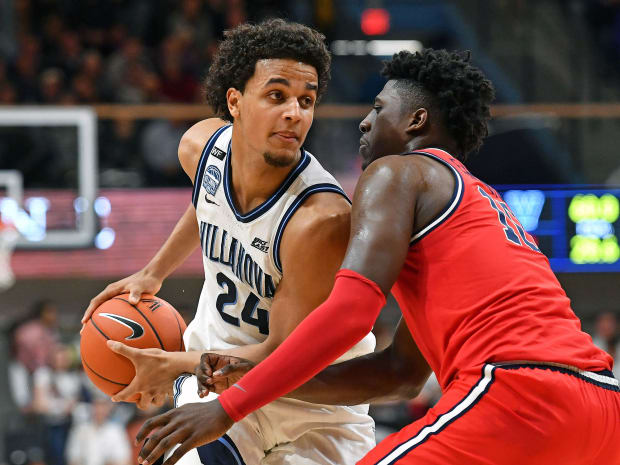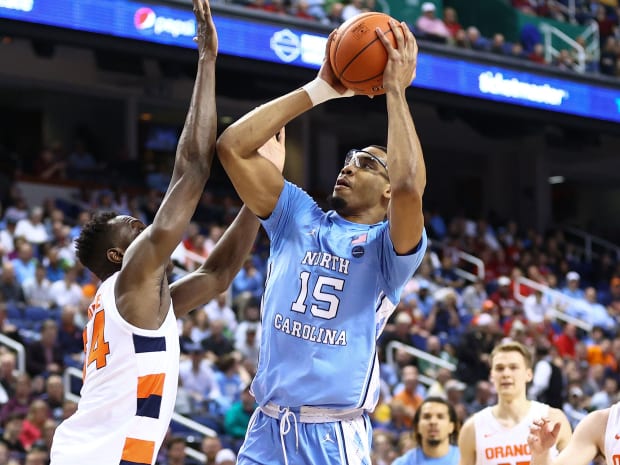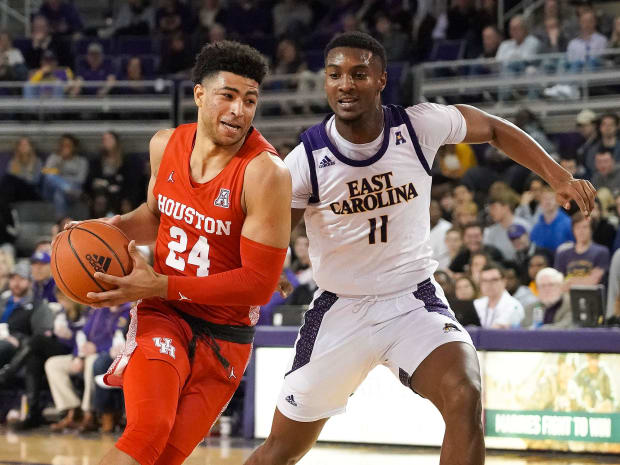Who cracked Pat Forde's list ahead of what promises to be an unpredictable 2020-21 college hoops season?
Sadly enough, the pandemic that ended the 2019–20 season abruptly on March 12 continues to rage at even higher numbers today. But college basketball is pushing forward, perhaps heedlessly, into a season that begins with approximately a million games Wednesday.
There will be postponements, cancellations and quite likely widespread chaos as the season attempts to lift off. Then there is the prospect of trying to land safely in March.
While all those twists and turns await, SI has produced a men’s preseason Top 25 for the least-predictable season any of us has ever seen:
1. Baylor
In a season as unconventional as this, why not pick a team to win it all that hasn’t even been to a Final Four since 1950? The Bears are flush with experience and maturity, which figures to matter when schedules are in tumult and the course of the season will not run smoothly. When Jared Butler and MaCio Teague both opted to return to school, Baylor had the building blocks for a special team. It also has one of the great do-whatever-it-takes players in the game in 6' 5", 250-pound strongman Mark Vital. Scott Drew has achieved consistent success in Waco, but this might be the team he was waiting for.
MORE: 2020–21 College Basketball Betting Preview
2. Gonzaga
Mark Few has an enviable program culture that is handed down, year over year, by his players. This team might have the Ultimate Few Guy in guard Corey Kispert—a great shooter, but also someone who says and does everything the head coach wants from his senior leader. The Zags have some outstanding athletes to go with Kispert, led by promising junior guard Joel Ayayi and touted freshman Jalen Suggs—the highest-rated recruit in Gonzaga history. The Zags may not have the interior scoring punch of last year with Filip Petrušev, but you know they’ll always have lots of size.

3. Villanova
Give Jay Wright some experienced guys and let him cook. This team returns four double-digit scorers from last season, and the lowest scorer in that group might turn out to be the star this time around in sophomore forward Jeremiah Robinson-Earl (10.5 points, 9.4 rebounds). He’s joined by a couple of trademark ‘Nova three-point shooters in Collin Gillespie and Justin Moore, plus bouncy forward Jermaine Samuels. The X-factor is sophomore guard Bryan Antoine, a five-star 2019 recruit who battled a shoulder issue last year and could be poised for a big leap up in minutes and production.
4. Illinois
The Illini were a young team riding an upward arc last season and had a chance for a splashy return to the Big Dance before the pandemic shut that down. Then top players Ayo Dosunmu (16.6 points, 3.3 assists) and Kofi Cockburn (13.3 points, 8.8 rebounds) both opted to stay in school, setting expectations soaring for this season. Trent Frazier also returns as a 30-minute-a-game guard, and freshman Adam Miller will be an instant-impact shooter who gets open looks when defenses are geared toward his teammates.
5. Virginia
Give it up for the longest-running defending champion ever. The Cavaliers never got a chance to follow up their 2019 NCAA title. But they were rolling at the end of last year, on an eight-game winning streak, and would have been a hard out. This year’s team should be much better offensively, with the arrival of Marquette transfer Sam Hauser and an expected step forward from sophomore guard Casey Morsell, while remaining a nightmare to score against. Kihei Clark will again run the team with patience, precision and tenacity. Tony Bennett has the pieces.
6. Iowa
It is an extreme rarity when a first-team All-American returns to school the following season, and the Hawkeyes are the beneficiary of that rarity this season. Big man Luka Garza, a 24-point, 10-rebound raging bull, anchors a team that returns all five starters from a 20-win season. Iowa will score a bunch; there are four players back who made at least 33 three-pointers last season, while Garza is a one-man wrecking crew inside. The questions are how well it will defend and how well volatile coach Fran McCaffery will handle top-10 expectations.
7. Kansas
This could be a Last Call season for the Jayhawks, who were heavy favorites to win the national title last spring before the pandemic and could be heading into an NCAA sanction nuclear winter before the 2021–22 season tips off. Bill Self never runs out of players and they always get better, so expect 2019–20 supporting actors Ochai Agbaji, David McCormack and Parker Braun to be ready for expanded roles. Wing Marcus Garrett returns as arguably the best defender in the college game. Freshman point guard Bryce Thompson fills an immediate need, if he’s ready to run the show.
8. Tennessee
The Volunteers have been to exactly zero Final Fours in their history. They had a very good team that made the Sweet 16 in 2019, but this one could be better. That ’18–19 team was built on experience and under-recruited players; this one has a higher ceiling due to Rick Barnes’s recent recruiting coups. Five-star guards Keon Johnson and Jaden Springer plus four-star forward Corey Walker join versatile rising star Yves Pons, the super-active John Fulkerson and others. A top-10 season would be a big jump up from a 17–14 season, but the talent plus some of that 2019 DNA are both there for Barnes to tap into.
9. Creighton
Greg McDermott’s most successful teams are always high-functioning offensive machines, and this should be one of his best. Marcus Zegarowski and Mitch Ballock might be the most lethal three-point duo in the country, having combined to make 164 of them last season. There is other returning experience and firepower to package with them. The Bluejays aren’t big and will likely remain vulnerable on the glass, but they are fully capable of outscoring most opposition.

10. North Carolina
Can a team really go from tied for last in the ACC to the national top 10 in one season? If anyone can, it’s the Tar Heels. Last year was an injury-plagued mess with a patchwork roster, as Roy Williams tried to win with a bad combination: overmatched grad transfers from mid-major programs and some very young players. This season he has Garrison Brooks returning after a Tyler Hansbrough-esque final six games (24 points and 10 free throws per game), and a dynamite freshman class. Guards Caleb Love and R.J. Davis should be ready to take on major roles in the backcourt. Carolina should have quality frontcourt depth as well.
11. Arizona State
In Year 6, it is time for Bobby Hurley to take command of the Pac-12. He has the most talented team, led by preseason All-America guard Remy Martin (more than 1,300 career points) and national top-30 recruits Josh Christopher and Marcus Bagley. Upperclassmen Kimani Lawrence, Alonzo Verge and Taeshon Cherry have played a lot of college ball and will be vital parts. Hurley also has enough depth to wear down opponents and, at least in theory, endure some potential COVID-19–related roster disruptions.
12. Kentucky
The Wildcats went from facing a rare glaring hole in the lineup back to customary flush-with-talent status when 7-foot Wake Forest transfer Olivier Sarr was granted immediate eligibility. That balances out a starting five that will rely heavily on freshman guards, most notably B.J. Boston and Terrence Clarke. Freshman Isaiah Jackson and sophomore Keion Brooks will get plenty of playing time in the frontcourt, but Sarr (13.7 points, 9 rebounds last year at Wake) gives John Calipari the interior presence he loves at both ends of the court. This season should follow the usual Kentucky storyline: struggle early, drive the demanding fans crazy, then round into form at the right time.
13. Florida State
Leonard Hamilton isn’t the kind of coach who relishes the idea of putting the ball in the hands of a freshman point guard—but Scottie Barnes isn’t an ordinary freshman point guard. He’s a 6' 9" five-star recruit and he will be counted on immediately. Barnes will have a veteran cast around him with three returning starters, and keep an eye on sophomore 7-footer Balsa Koprivica (of federal investigation fame). He was off to a promising start last season before a back injury derailed his season. For the 14th straight season Leonard Hamilton has at least one 7-footer on the roster (actually two, plus a guy listed at 6' 11"). Expect FSU to be what it always is: long, athletic and fierce.
14. Michigan State
This is one of those rare occasions where two or more Big Ten teams are well ahead of the Spartans on paper. But none of those teams are coached by Tom Izzo, who is among the most reliable 20-win guys in the history of the sport (at least in seasons where teams play a full schedule). He is replacing the program’s heartbeat in Cassius Winston, but has a deep roster of complementary players for what should be more of a win-by-committee season in East Lansing. Adding the other Hauser transfer, Joey, will also make a big impact at the offensive end.
15. Duke
The Blue Devils don’t have a Zion Williamson, a Marvin Bagley III or a Vernon Carey on this year’s roster. But they do have four five-star freshmen to go along with talented sophomores Matthew Hurt and Wendell Moore. From the tall (Mark Williams and Jalen Johnson) to the small (D.J. Steward and Jeremy Roach), Mike Krzyzewski’s freshman class again will be among the very best in the nation. One X-factor to watch with Duke: With no fans at Cameron Indoor Stadium, will the Blue Devils’ famed home court advantage be diminished? “That’s like a 14-point advantage they don’t have,” said one ACC coach.
16. Wisconsin
Greg Gard has been both the right fit to replace Bo Ryan and … not yet capable of hitting the high notes of Bo Ryan. He might have changed the latter part of that last March, had there been a tournament, when the Badgers ripped off eight straight wins to end the regular season with a share of the Big Ten title. This year he has another—and perhaps even better—chance. Almost everyone of note is back from that team, led by frontcourt players Nate Reuvers and Micah Potter and guards D'Mitrik Trice and Brad Davison. In a stacked Big Ten, Wisconsin should take a backseat to nobody.
17. West Virginia
We are all anxiously awaiting the sideline sight of Bob Huggins Nov. 25 when the Mountaineers open the season, to see if Huggs has maintained his Quarantine Chic. During the offseason, Huggins has resembled an aging country music legend—hair grown out, bearded, missing only a black cowboy hat and an acoustic guitar. But there will be no country-song sadness to sing about his basketball team, if it lives up to billing. West Virginia has quality size in Oscar Tshiebwe and Derek Culver, a promising point guard in sophomore Miles McBride, and enough other pit bulls to play Huggins’ preferred attacking defensive style. The question, always, is whether WVU can make enough shots.
18. UCLA
Mick Cronin’s first year in Westwood started with cringe-worthy slowness (the Bruins were 8–9 in mid-January) and ended with a runner-up finish in the Pac-12. Cronin knows what he’s doing; it just took a while to get his players to know what they’re doing within his style of play. Expect the growth of the final two months last season to carry over to this one, since all five starters are back. Kentucky transfer Johnny Juzang and freshman guard Jaylen Clark will add some quality depth and should increase UCLA’s defensive aggressiveness and tempo.

19. Houston
If you give Kelvin Sampson a wrench and a bag of nuts and bolts, he will build a sports car. He’s that good at assembling teams and winning games, no matter what the roster looks like. That will be the case with this team, despite Nate Hinton surprisingly going pro (and going undrafted) and the season-ending injury to Fabian White. Those were the only two players to start every game last season, but guards Caleb Mills, Marcus Sasser and Quentin Grimes made the team go in 2019–20 and will do so again this year.
20. Texas Tech
Chris Beard is well known as a phenomenal game coach and tactician, but it’s time to recognize his prowess as a recruiter. He’s keeping the Red Raiders relevant because he keeps landing quality players. For this year’s team, that means adding five-star freshman guard Nimari Burnett and a pair of transfers: Georgetown’s Mac McClung and VCU’s Marcus Santos-Silva. The leading holdover player is Kyler Edwards, who slumped at the end of last season but should bounce back to play a big role on this team.
21. Ohio State
The Buckeyes took significant strides offensively last season under Chris Holtmann, and a big part of that was the development of guard C.J. Walker (Florida State transfer) and freshman forward E.J. Liddell. Give those two a second season together and the dividends should be significant. Is Ohio State a cut below the top tier in a loaded Big Ten? Probably. But Holtmann’s team is always going to guard, which makes them a reliable pain in the neck to play in a rough-and-tumble conference.
22. Texas
Four teams from the state of Texas in the preseason Top 25? It’s true. Shaka Smart’s tenure has been generally underwhelming, but he kept his job after a 19–12 season and may hit paydirt here in Year 6 (and not just because his shaved head is now covered in hair). The Longhorns have all five starters back and add another recruiting coup by keeping five-star forward Greg Brown home in Austin. The Big 12 is stacked, as usual, but Texas should have the goods to produce Smart’s first winning conference record since 2016.
23. San Diego State
The Aztecs are coming off a brilliant, 30–2 season, and the losses from that team were understandably considerable. But resourceful, versatile Matt Mitchell is back, and Brian Dutcher has been successful at doing what his predecessor Steve Fisher did—developing players and expanding roles for the next group. The major addition is CSU-Northridge transfer Terrell Gomez, a 20-point-a-game scorer, the latest in a long line of quality transfers SDSU has added.
24. Oregon
Point guard Payton Pritchard so totally dominated everything the Ducks did last year that it’s a little bit difficult to imagine them without him. But Dana Altman always has players, and always knows what to do with them. Guard Chris Duarte figures to step into the starring role, with help from redshirt freshman center N’Faly Dante and transfers Amauri Hardy (UNLV), Eugene Omoruyi (Rutgers) and Eric Williams (Duquesne).
25. Dayton
The dream season ended in emptiness, and then the superstar player left for the NBA lottery. A 29-win season and a generational talent don’t happen every year, or every decade, at the Dayton level. But don’t for a minute think that Anthony Grant’s program is cooked. Guard Jalen Crutcher (Obi Toppin’s running mate on the popular Toppin/Crutcher 2020 shirts on campus) is back, and he’s very good. Fellow guard Rodney Chatman returns as well. Grant has redshirted extensively, and now it’s time for some of those players to step into more important roles, especially in the frontcourt.